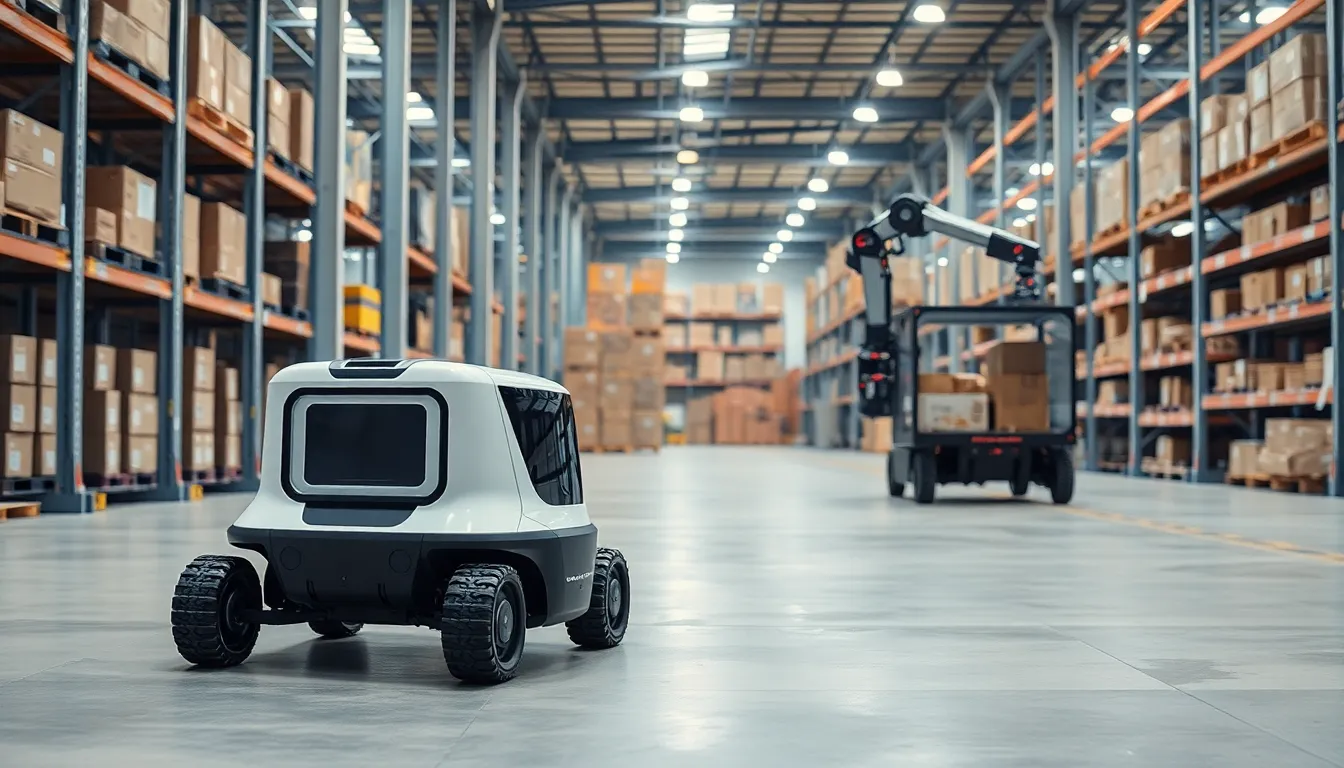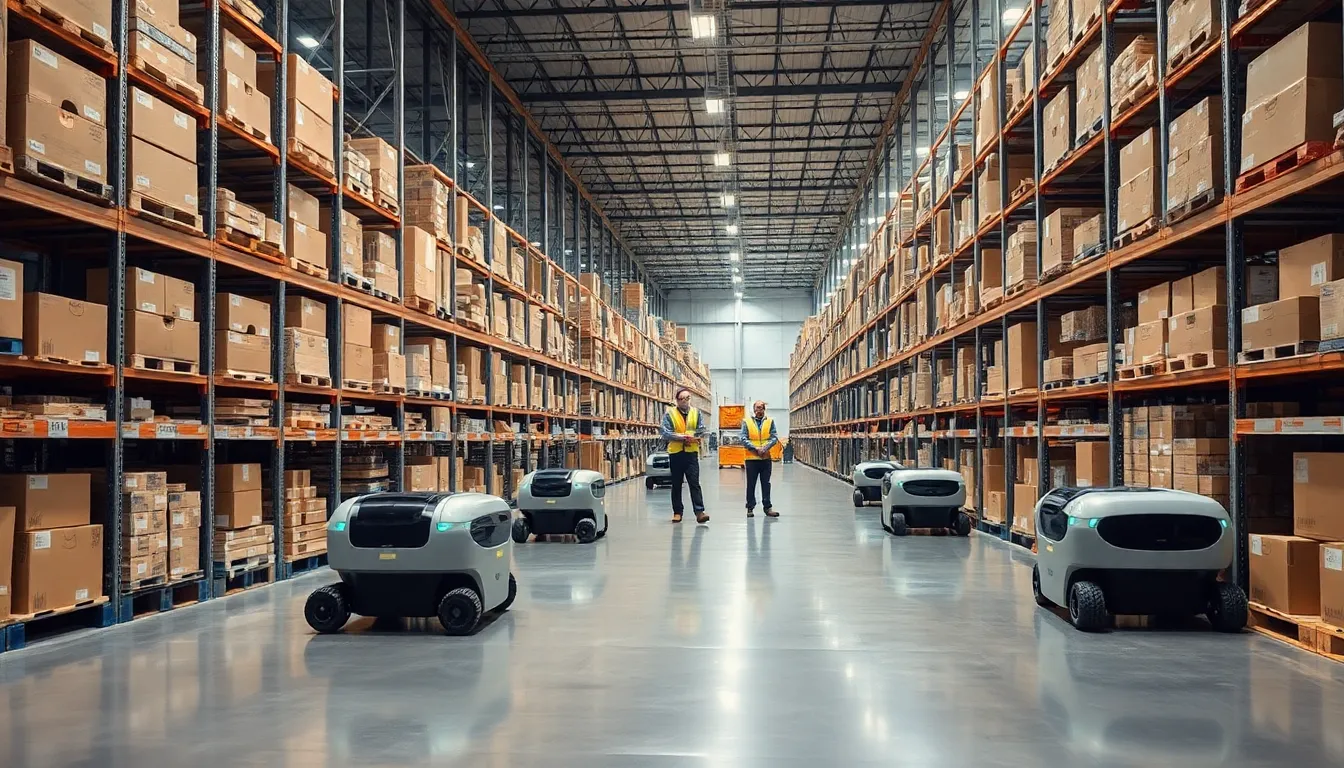In the bustling world of logistics, warehouse robots are the unsung heroes tirelessly zipping around like caffeinated squirrels on a mission. These mechanical marvels aren’t just here to impress with their slick moves; they’re revolutionizing how businesses handle inventory and streamline operations. Imagine a workforce that never tires, doesn’t need coffee breaks, and can outpace even the most enthusiastic warehouse worker. Sounds like a dream, right?
But it’s not just about speed; these robots are also masters of precision, ensuring that every item is in its rightful place. With advancements in technology, they’re becoming smarter and more efficient, making the warehouse a well-oiled machine. As companies look to boost productivity and cut costs, embracing these robotic wonders isn’t just a trend—it’s a necessity. Get ready to discover how warehouse robots are transforming the industry and why they might just be the best thing since sliced bread.
Table of Contents
ToggleOverview of Warehouse Robots
Warehouse robots play a vital role in modern logistics operations. These machines streamline various processes such as picking, packing, and transportation of goods. Their use significantly reduces human error, enhancing overall accuracy in inventory management.
Robotic systems in warehouses include autonomous mobile robots (AMRs) and automated guided vehicles (AGVs). AMRs navigate through dynamic environments using advanced sensors, while AGVs follow fixed paths to move products. Both types contribute to faster order fulfillment.
Speed remains a key advantage of warehouse robots. They can operate continuously, increasing throughput without fatigue. Companies benefit from reduced labor costs as robots take on repetitive tasks, allowing staff to focus on higher-value activities.
Data from recent studies show that implementing robotic solutions can improve efficiency by 20% to 30%. This shift leads to shorter delivery times and better customer satisfaction. Robots’ ability to process larger volumes of products supports scalability in operational needs.
Additionally, advancements in machine learning and artificial intelligence enhance robotic capabilities. These technologies enable robots to learn from their environments and adapt to changing warehouse layouts. As the industry evolves, investing in smart warehouse robots becomes increasingly important for maintaining competitive advantages.
With a focus on safety, warehouse robots help minimize workplace accidents. By handling hazardous tasks, they create safer environments for employees. Overall, the integration of robots into warehouse operations represents a strategic move towards innovation and growth.
Types of Warehouse Robots

Various types of robots play crucial roles in enhancing warehouse operations. These robotic solutions improve efficiency, accuracy, and safety across different tasks.
Autonomous Mobile Robots
Autonomous mobile robots (AMRs) navigate warehouses using sophisticated sensors and artificial intelligence. They optimize picking and shelving by identifying paths and avoiding obstacles. AMRs efficiently transport goods, reducing reliance on human labor. Their ability to learn and adapt to new environments increases productivity in dynamic settings. Studies show that AMRs can elevate operational efficiency by at least 20%.
Automated Guided Vehicles
Automated guided vehicles (AGVs) primarily focus on material transportation within warehouses. They operate on predetermined paths, following magnetic strips or laser guidance systems for navigation. AGVs excel in delivering items between specific areas, ensuring consistent workflow. Unlike AMRs, they require less complex navigation technologies, making them easier to implement in many environments. With AGVs, businesses experience lower labor costs and enhanced speed in handling goods.
Robotic Arms
Robotic arms specialize in tasks that involve picking, packing, and sorting products. They mimic human dexterity and perform repetitive tasks with high precision. Equipped with advanced vision systems, these robotic arms can identify items, reducing the likelihood of errors. Their flexibility allows for quick adjustments, making them suitable for various applications within warehouse operations. Implementing robotic arms can lead to significant time savings, ultimately increasing overall productivity.
Benefits of Implementing Warehouse Robots
Warehouse robots offer significant advantages in modern logistics. Their integration into operations leads to improved efficiency and cost savings.
Increased Efficiency
Increased efficiency stands as a primary benefit of warehouse robots. Robots can operate continuously, achieving throughput levels that human workers cannot match. Studies indicate a potential 20% to 30% boost in operational efficiency after implementing robotic solutions. These machines streamline tasks such as picking, packing, and transportation, reducing the time taken to fulfill orders. With enhanced accuracy, robots also minimize errors associated with manual labor. Moreover, their ability to adapt to changes in the environment using advanced machine learning ensures optimal performance at all times.
Cost-Effectiveness
Cost-effectiveness emerges as another key advantage of deploying warehouse robots. By automating repetitive tasks, companies reduce labor costs significantly. The initial investment in robotic systems often pays off through increased productivity and reduced operational expenses. In addition, robots decrease the frequency of workplace accidents, which can further lower insurance costs and legal liabilities. With shorter delivery times, businesses can enhance customer satisfaction and repeat business. Overall, the integration of warehouse robots not only streamlines processes but also improves overall financial performance.
Challenges in Warehouse Robot Integration
Warehouse robot integration presents notable challenges that businesses must address to fully realize the benefits of automation.
Technology Barriers
Technology limitations often impede seamless warehouse robot integration. Outdated infrastructure may hinder the implementation of advanced robotic systems. Many existing warehouse layouts lack the adaptability required for effective robot navigation. Additionally, interoperability issues can arise between different robotic systems and legacy software. Data security concerns also play a significant role, as integrating robots might expose sensitive information. Overcoming these barriers demands significant investment in both hardware and software upgrades to ensure compatibility.
Workforce Considerations
Workforce considerations remain critical during the transition to automation. Employees may experience fear regarding job displacement, leading to resistance against adopting robotic systems. Effective communication is essential to address these concerns and emphasize how robots can enhance human roles rather than replace them. Training programs must be implemented to upskill workers, preparing them for collaboration with robots in various tasks. Adapting to this change requires a cultural shift within the organization, ensuring that both management and staff understand the potential benefits of integration.
Future Trends in Warehouse Robotics
Warehouse robotics continues evolving with promising trends that will define the logistics landscape. Emerging technologies, especially artificial intelligence and machine learning, enhance warehouse robot capabilities.
Advancements in AI and Machine Learning
Machine learning and AI significantly improve warehouse robots’ operational efficiency. Sophisticated algorithms enable robots to learn from their environments, adapt to variations, and optimize workflows. For example, data-driven insights lead to better inventory management, as robots accurately predict stock levels and demand fluctuations. These advancements reduce human errors while enhancing decision-making processes. Research shows that companies integrating AI alongside robotics can see efficiency gains exceeding 30%. These trends showcase the importance of AI and machine learning in shaping future logistics operations.
Robotics in E-Commerce
E-commerce growth drives the adoption of warehouse robotics, transforming how goods are handled. Increased online shopping has heightened demand for fast order fulfillment, necessitating automated solutions. Robots now play vital roles in processes like sorting, packing, and shipping, crucial for meeting quick delivery expectations. In fact, integration of robotic systems results in 25% faster order processing times. Companies that leverage robotics in their fulfillment centers can respond swiftly to changing market needs, maintaining a competitive advantage. Enhanced efficiency through robotics supports businesses in meeting growing customer demands effectively.
Warehouse robots are revolutionizing the logistics industry by driving efficiency and precision in operations. Their ability to work continuously without breaks allows businesses to streamline processes and boost productivity significantly. As technology continues to advance, the integration of AI and machine learning will further enhance these robots’ capabilities, enabling them to adapt and optimize workflows.
While challenges in adoption exist, the benefits of increased safety, reduced labor costs, and improved accuracy make a compelling case for their implementation. Companies that embrace warehouse robotics will not only meet the demands of a fast-paced market but also position themselves for future growth and innovation. The future of logistics is undeniably tied to the evolution of robotic systems, making them an essential component of modern supply chains.





